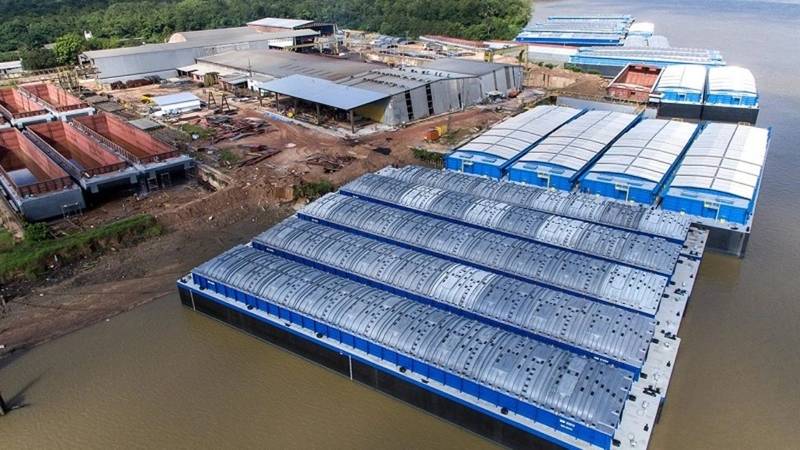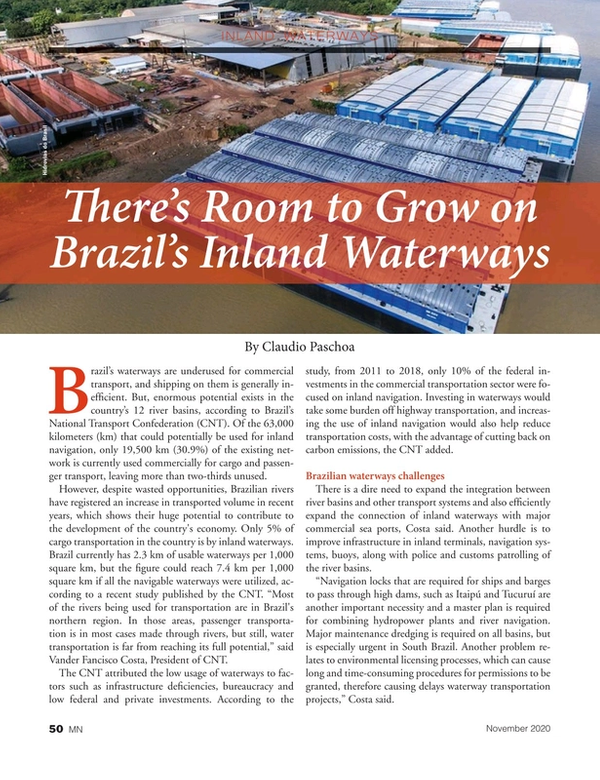
There’s Room to Grow on Brazil’s Inland Waterways
Brazil’s waterways have enormous potential for commercial transport, but are still underused and inefficient in the country’s 12 river basins, according to Brazil’s National Transport Confederation (CNT). Of the 63,000 kilometers (km) that could potentially be used for inland navigation, only 19,500 km (30.9%) of the existing network is currently used commercially for cargo and passenger transport, leaving more than two-thirds unused.
However, despite wasted opportunities, Brazilian rivers have registered an increase in transported volume in recent years, which shows their huge potential to contribute to the development of the country's economy. Only 5% of cargo transportation in the country is by inland waterways. Brazil currently has 2.3 km of usable waterways per 1,000 square km, but the figure could reach 7.4 km per 1,000 square km if all the navigable waterways were utilized, according to a recent study published by the CNT. “Most of the rivers being used for transportation are in Brazil's northern region. In those areas, passenger transportation is in most cases made through rivers, but still, water transportation is far from reaching its full potential,” said Vander Fancisco Costa, President of CNT.
The CNT attributed the low usage of waterways to such factors as deficient infrastructure, bureaucracy and low federal and private investments. According to the study, from 2011 to 2018, only 10% of the federal investments in the commercial transportation sector were focused on inland navigation. Investing in waterways would take some burden off highway transportation, and increasing the use of inland navigation would also help reduce transportation costs, with the advantage of cutting back on carbon emissions, the CNT added.
Brazilian waterways challenges
Costa said there is a dire need to expand the integration between river basins and other transport systems and also efficiently expand the connection of inland waterways with major commercial sea ports. Another hurdle is to improve infrastructure in inland terminals, navigation systems, buoys, along with police and customs patrolling of the river basins.
“Navigation locks that are required for ships and barges to pass through high dams, such as Itaipú and Tucuruí are another important necessity and a master plan is required for combining hydropower plants and river navigation. Major maintenance dredging is required on all basins, but is especially urgent in South Brazil. Another problem relates to environmental licensing processes, which can cause long and time-consuming procedures for permissions to be granted, therefore causing delays waterway transportation projects,” Costa said.
 (Photo: ERM)
(Photo: ERM)
Brazilian waterways opportunities
“There is an ongoing plan to design new navigation channels, locks and other structures to overcome missing links in the waterway systems in order to enhance the efficiency of inland waterway transportation,” Costa said. CNT is also preparing an integrated plan for the logistics of transport over water and land in order to increase efficiency and safety. Costa also emphasized that work is ongoing on the implementation of advanced navigation systems for increased safety and guaranteeing optimal navigational conditions, even in adverse weather conditions. Negotiations are underway with foreign governments, businesses and academia to secure technology transfer in the fields of hydrodynamics, morphology, nautical expertise and modelling through the National Institute of Waterway Research (INPH). It is hoped that these partnerships will also attract foreign investments as a lack of robust public policies toward increasing the commercial use of inland waterways over the past decades has led the country to delay its economic development, emit more greenhouse gases than necessary and lose much needed income. Such factors could be reduced if there was a balance between the inland waterway modality and cabotage, road, air and rail transport. As it is, investments are lopsided and the vast majority of commercial transportation in Brazil is done through highways.
Novel LNG barge project
Last year Rolls-Royce signed an agreement with the Brazilian company Amazonica Energy to develop barges and tugs powered by natural gas that will be used in the commercialization of liquefied natural gas (LNG) in northern Brazil. The partnership is to be run through Rolls-Royce subsidiary MTU. The investment in the development of the vessels is estimated at around $2 million to start. In all, 30 barges will be built by 2021. The construction of the barge trains will be done by Rio Maguari Shipyard (ERM), in the city of Belém, located in the northern state of Pará. The logistical project for transport and distribution of LNG in the northern region, conceived by Amazonica Energy, foresees the construction of 20 barges and five or six pushers in the first phase. The goal is to build the units beginning this year. Each of these pusher engines will have a power of approximately 4,200 horsepower and each barge will carry 1,200 cubic meters of gas.
Read There’s Room to Grow on Brazil’s Inland Waterways in Pdf, Flash or Html5 edition of November 2020 Marine News
Other stories from November 2020 issue
Content
- Interview: John Batten, CEO, Twin Disc page: 12
- Implementing VIDA: The Next Step Forward page: 26
- River Dance: Grounding Triggers Breakaway Barges page: 29
- Historic Dredging Unlocks the Might of the Mississippi page: 32
- US Inland Waterways: High Waters & Swirling Currents page: 44
- There’s Room to Grow on Brazil’s Inland Waterways page: 50
- Propeller Considerations for Inland River Pushboats page: 54
- In Focus: Talking Workboat Safety with AWO's Brian Bailey page: 60


